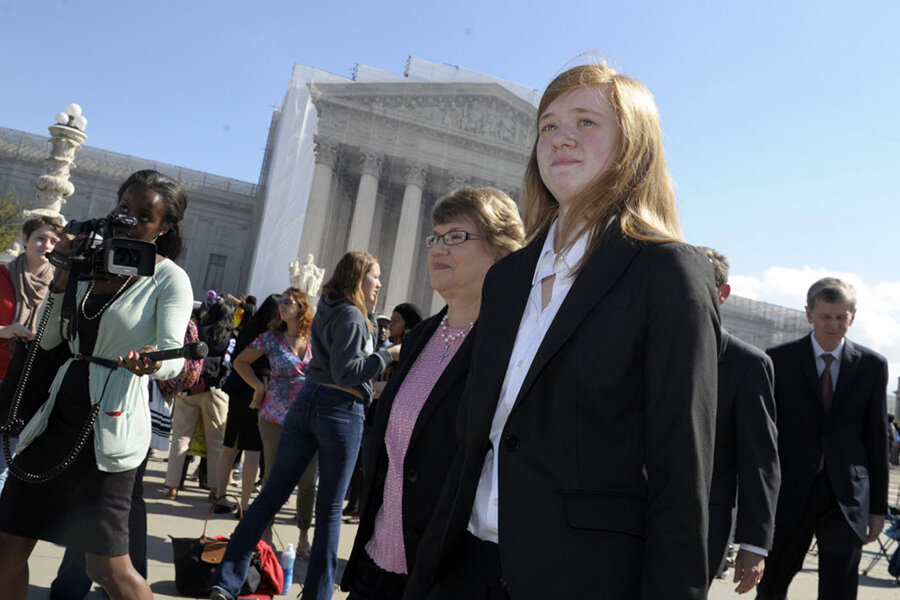Supreme Court upholds affirmative action: What will it mean for students?
Loading...
In a closely-watched case, the Supreme Court on Thursday rejected a challenge to a race-conscious admissions program at the University of Texas at Austin.
In a 4-3 decision, the court sided with the university, dismissing arguments from Abigail Fisher, a white woman denied admission to UT Austin in the fall of 2008 whose case was backed by a prominent conservative legal group.
Writing for the court, Justice Anthony Kennedy noted that the university’s admissions program was unique and had been affirmed by the Texas legislature.
“A university is in large part defined by those intangible ‘qualities which are incapable of objective measurement but which make for greatness,’ ” Justice Kennedy wrote, quoting from a landmark desegregation case that challenged the “separate but equal” doctrine.
“Considerable deference is owed to a university in defining those intangible characteristics, like student body diversity, that are central to its identity and educational mission,” he added.
By saying that universities deserved “considerable deference” in how they make admissions decisions, the court handed what one advocate calls a “resounding victory” to supporters of affirmative action, who say race deserves to be considered, along with a variety of other factors, in how colleges admit their students. The decision could also provide a road map for how other universities design policies intended to attract a diverse student body, says Liliana Zaragoza of the NAACP’s Legal Defense and Educational Fund.
"This is very much a green light from the Supreme Court, that [universities] should continue to use race as ‘but a factor of a factor of a factor,’ " Ms. Zaragoza, the group's John Payton Appellate and Supreme Court Advocacy Fellow, says in a phone interview.
“It is a part of each student, it is their reality, looking at their race among other factors, such as class and gender is what universities ought to do and what they are now permitted to do legally,” she says.
Tuesday’s decision was the second time the court had heard the case. In 2013, it previously sent it back to an appeals court – which had endorsed Texas’ program – for further review.
This time around, the court rejected Ms. Fisher’s argument that the decision not to admit her violated the Constitution’s guarantee of equal protection under the law.
The Texas program initially admits any student who graduates from a Texas high school in the top 10 percent of their class.
But Fisher, who was not in the top 10 percent of her class, challenged a second part of the admission policy, a “holistic review” that typically admits an additional 25 percent of students each year by combining an applicant’s academic performance in high school with a number of factors, including an applicant’s family responsibilities and their race.
Kennedy, who was joined by Justices Ruth Bader Ginsburg, Stephen Breyer, and Sonia Sotomayor, said the challengers hadn’t been able to demonstrate that the university could use other means beyond race to create a more diverse student body.
Fisher, who later attended Louisiana State University and works in finance in Austin, had argued that the decision to deny her admission came after the university admitted less qualified African-American and Latino students. The university, however, questioned whether she would have gained admission under any circumstances.
Ruthann Robson, a professor at the City University of New York School of Law, says Thursday's decision may mark a shift in Kennedy's views on the role of affirmative action.
“It does seem, however, that Justice Kennedy’s views on race may be altering,” she writes in an email to the Monitor, noting that this case was the first time Kennedy had sided in favor of affirmative action.
She also pointed to his opinion upholding the ability of people to sue to contest housing discrimination even if a Realtor or government agency didn’t intentionally engage in bias in a 2015 case.
In a stinging dissent that he read from the bench Thursday, Justice Samuel Alito dismissed the majority’s decision, saying the university hadn’t demonstrated the need for race-based admissions. “This is affirmative action gone berserk,” he told his colleagues, The New York Times reports.
“These are laudable goals, but they are not concrete or precise and they offer no limiting principle for the use of racial preferences,” he wrote in a dissent joined by Justice Clarence Thomas and Chief Justice John Roberts. Justice Elena Kagan recused herself from the case, citing her prior work as the US solicitor general.
The court’s ruling is somewhat limited, notes Professor Robson of CUNY, and the decision cautions that universities must carefully review their policies.
“If the Court did not uphold this affirmative action plan against an Equal Protection Clause challenge by an unsuccessful white applicant, then it was unlikely that any affirmative action plan using race could be constitutional,” she writes.
Ms. Zaragoza of the Legal Defense and Educational Fund says the court’s decision could also provide a model for future challenges.
The Project on Fair Representation, a conservative legal group founded by former Austin stockbroker Edward Blum, which backed Fisher’s case against Texas, is currently challenging race-based admissions at Harvard University and the University of North Carolina Chapel Hill.
“This definitely signals to those organizations that using race in admissions is acceptable where the university has created a thoughtful program,” she says.
“Hopefully this will send a message to future challengers to be careful and beware, and at the very least they should have a higher standard for bringing these challenges in the future.”







